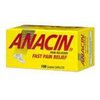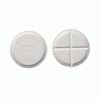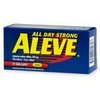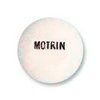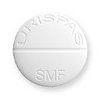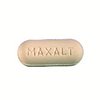INDICATIONS
Anacin is used for treating pain including, headache, muscle aches, sprains, tooth extraction and toothache, menstrual cramps, arthritis and rheumatism, and pain and fever of the common cold. It may also be used for other conditions as determined by your doctor.
INSTRUCTIONS
Use Anacin as directed by your doctor. Check the label on the medicine for exact dosing instructions.
Take Anacin by mouth with or without food. If stomach upset occurs, take with food to reduce stomach irritation. Taking it with food may not decrease the risk of stomach or bowel problems (eg, bleeding, ulcers) that may occur while taking Anacin.
Take Anacin with a full glass of water (8 oz/240 mL). Do not lie down for 30 minutes after taking Anacin.
Use Anacin exactly as directed on the package, unless instructed differently by your doctor. If you are taking Anacin without a prescription, follow any warnings and precautions on the label.
If you miss a dose of Anacin and you are taking it regularly, take it as soon as possible. If it is almost time for your next dose, skip the missed dose and go back to your regular dosing schedule. Do not take 2 doses at once.
Ask your health care provider any questions you may have about how to use Anacin.
STORAGE
Store Anacin at room temperature, between 68 and 77 degrees F (20 and 25 degrees C). Store away from heat, moisture, and light. Do not store in the bathroom. Keep Anacin out of the reach of children and away from pets.
MORE INFO:
Anacin may cause dizziness. These effects may be worse if you take it with alcohol or certain medicines. Use Anacin with caution. Do not drive or perform other possibly unsafe tasks until you know how you react to it.
Avoid large amounts of food or drink that have caffeine (eg, coffee, tea, cocoa, cola, chocolate). This includes any medicines that contain caffeine.
Anacin has aspirin in it. Before you start any new medicine, check the label to see if it has aspirin in it too. If it does or if you are not sure, check with your doctor or pharmacist.
Talk to your doctor before you take Anacin or other pain relievers/fever reducers if you drink more than 3 drinks with alcohol per day. Serious stomach ulcers or bleeding can occur with the use of Anacin. Taking it in high doses or for a long time, smoking, or drinking alcohol increases the risk of these side effects. Taking Anacin with food will NOT reduce the risk of these effects. Contact your doctor or emergency room at once if you develop severe stomach or back pain; black, tarry stools; vomit that looks like blood or coffee grounds; or unusual weight gain or swelling.
Do NOT take more than the recommended dose or use for longer than prescribed without checking with your doctor. Taking more than the recommended dose or taking Anacin regularly may be habit-forming.
Anacin may reduce the number of clot-forming cells (platelets) in your blood. To prevent bleeding, avoid situations in which bruising or injury may occur. Report any unusual bleeding, bruising, blood in stools, or dark, tarry stools to your doctor.
Aspirin has been linked to a serious illness called Reye syndrome. Do not give Anacin to a child or teenager who has the flu, chickenpox, or a viral infection. Contact your doctor with any questions or concerns.
Diabetes patients - Anacin may affect your blood sugar. Check blood sugar levels closely. Ask your doctor before you change the dose of your diabetes medicine.
If Anacin has a strong vinegar-like smell upon opening, do not use. It means the medicine is breaking down. Throw the bottle away safely and out of the reach of children; contact your pharmacist and replace.
Tell your doctor or dentist that you take Anacin before you receive any medical or dental care, emergency care, or surgery.
Do not take Anacin for at least 7 days after any surgery unless directed by your health care provider.
Do not take Anacin for more than 10 days for pain or for more than 3 days for fever unless directed to do so by your health care provider.
Different brands of Anacin may have different dosing instructions for CHILDREN. Follow the dosing instructions on the package labeling. If your doctor has given you instructions, follow those. If you are unsure of the dose to give a child, check with your doctor or pharmacist.

